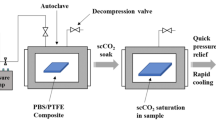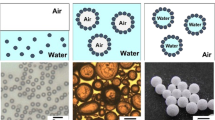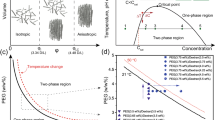Abstract
Small particles attached to liquid surfaces arise in many products and processes, including crude-oil emulsions and food foams and in flotation, and there is a revival of interest in studying their behaviour. Colloidal particles of suitable wettability adsorb strongly to liquid–liquid and liquid–vapour interfaces1, and can be sole stabilizers of emulsions2 and foams3, respectively. New materials, including colloidosomes4, anisotropic particles5 and porous solids6, have been prepared by assembling particles at such interfaces. Phase inversion of particle-stabilized emulsions from oil in water to water in oil can be achieved either by variation of the particle hydrophobicity (transitional)7 or by variation of the oil/water ratio (catastrophic)8. Here we describe the phase inversion of particle-stabilized air–water systems, from air-in-water foams to water-in-air powders and vice versa. This inversion can be driven either by a progressive change in silica-particle hydrophobicity at constant air/water ratio or by changing the air/water ratio at fixed particle wettability, and has not been observed in the corresponding systems stabilized by surfactants. The simplicity of the work is that this novel inversion is achieved in a single system. The resultant materials in which either air or water become encapsulated have potential applications in the food, pharmaceutical and cosmetics industries.
This is a preview of subscription content, access via your institution
Access options
Subscribe to this journal
Receive 12 print issues and online access
$259.00 per year
only $21.58 per issue
Buy this article
- Purchase on Springer Link
- Instant access to full article PDF
Prices may be subject to local taxes which are calculated during checkout




Similar content being viewed by others
References
Binks, B. P. & Horozov, T. S. (eds) Colloidal Particles at Liquid Interfaces (Cambridge Univ. Press, Cambridge, 2006).
Melle, S., Lask, M. & Fuller, G. G. Pickering emulsions with controllable stability. Langmuir 21, 2158–2162 (2005).
Alargova, R. G., Warhadpande, D. S., Paunov, V. N. & Velev, O. D. Foam superstabilization by polymer microrods. Langmuir 20, 10371–10374 (2004).
Dinsmore, A. D. et al. Colloidosomes: Selectively permeable capsules composed of colloidal particles. Science 298, 1006–1009 (2002).
Velev, O. D., Lenhoff, A. M. & Kaler, E. W. A class of microstructured particles through colloidal crystallization. Science 287, 2240–2243 (2000).
Binks, B. P. Macroporous silica from solid-stabilized emulsion templates. Adv. Mater. 14, 1824–1827 (2002).
Binks, B. P. & Lumsdon, S. O. Influence of particle wettability on the type and stability of surfactant-free emulsions. Langmuir 16, 8622–8631 (2000).
Binks, B. P. & Lumsdon, S. O. Catastrophic phase inversion of water-in-oil emulsions stabilized by hydrophobic silica. Langmuir 16, 2539–2547 (2000).
Ramsden, W. Separation of solids in the surface-layers of solutions and ‘suspensions’-preliminary account. Proc. R. Soc. 72, 156–164 (1903).
Pickering, S. U. Emulsions. J. Chem. Soc. 91, 2001–2021 (1907).
Binks, B. P. & Horozov, T. S. Aqueous foams stabilized solely by silica nanoparticles. Angew. Chem. Int. Edn 44, 3722–3725 (2005).
Aussillous, P. & Quéré, D. Liquid marbles. Nature 411, 924–927 (2001).
Schutte, D., Schmitz, F.-T. & Brünner, H. Predominantly aqueous compositions in a fluffy powdery form approximating powdered solids behaviour and process for forming same. Patent assigned to Deutsche Gold- und Silber-Scheideanstaldt vormals Roessler, Germany, US 3,393,155 (1968).
Hasenzahl, S., Gray, A., Walzer, E. & Braunagel, A. Dry water for the skin. SÖFW-J. 131, 2–8 (2005).
Barthlott, W. & Neinhuis, C. Purity of the sacred lotus, or escape from contamination in biological surfaces. Planta 202, 1–8 (1997).
Pike, N., Richard, D., Foster, W. & Mahadevan, L. How aphids lose their marbles. Proc. R. Soc. Lond. B 269, 1211–1215 (2002).
Kostakis, T., Ettelaie, R. & Murray, B. S. Effect of high salt concentration on the stabilization of bubbles by silica particles. Langmuir 22, 1273–1280 (2006).
Vella, D., Aussillous, P. & Mahadevan, L. Elasticity of an interfacial particle raft. Europhys. Lett. 68, 212–218 (2004).
Subramaniam, A. B., Abkarian, M., Mahadevan, L. & Stone, H. A. Non-spherical bubbles. Nature 438, 930 (2005).
Kralchevsky, P. A., Ivanov, I. B., Ananthapadmanabhan, K. P. & Lips, A. On the thermodynamics of particle-stabilized emulsions: curvature effects and catastrophic phase inversion. Langmuir 21, 50–63 (2005).
Acknowledgements
We thank the EPSRC, UK, for a postdoctoral grant to R.M., T. Gottschalk-Gaudig, Wacker-Chemie (Burghausen) for the donation of the fumed silica powders and A. Sinclair, University of Hull, for carrying out the SEM analysis.
Author information
Authors and Affiliations
Contributions
R.M. carried out the experimental work.
Corresponding author
Ethics declarations
Competing interests
The authors declare no competing financial interests.
Rights and permissions
About this article
Cite this article
Binks, B., Murakami, R. Phase inversion of particle-stabilized materials from foams to dry water. Nature Mater 5, 865–869 (2006). https://doi.org/10.1038/nmat1757
Received:
Accepted:
Published:
Issue Date:
DOI: https://doi.org/10.1038/nmat1757
This article is cited by
-
Fabrication of porous poly(methyl methacrylate)/palygorskite microspheres via pickering emulsion templated continuous-flow photopolymerization
Journal of Polymer Research (2023)
-
Self-assembly of nanoparticles at solid–liquid interface for electrochemical capacitors
Rare Metals (2022)
-
Interfacial Strategies for Smart Slippery Surfaces
Journal of Bionic Engineering (2020)
-
Sustained release of an essential oil by a hybrid cellulose nanofiber foam system
Cellulose (2020)
-
Solvent-Free Synthetic Fe3O4@ZIF-8 Coated Lipase as a Magnetic-Responsive Pickering Emulsifier for Interfacial Biocatalysis
Catalysis Letters (2020)



